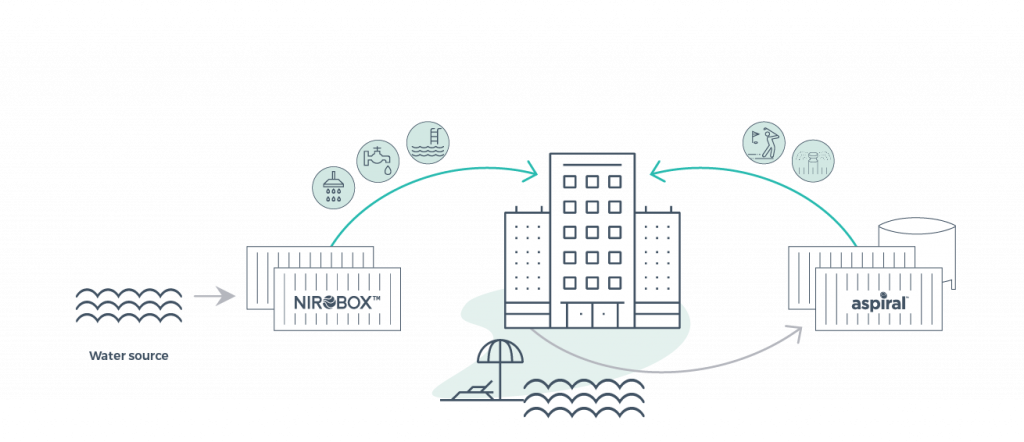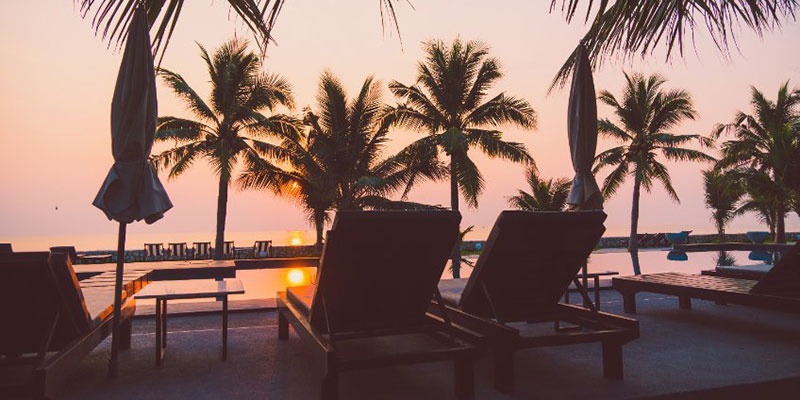Because of their unlimited access to seawater, coastal and island resorts can benefit from desalination.
With natural water cycles faltering, coastal and island resorts can rely on full water-cycle solutions for the water they need to operate
Earth’s water cycle is the continuous process of evaporation, condensation, and precipitation that purifies this natural resource. Water is drawn into the atmosphere as vapor. It then falls as precipitation, percolates into aquifers, or runs into water bodies to begin the cycle anew.
As populations have increased, the natural systems that provide water have been unable to keep up with demand. In response, some entities have established their own water cycles to treat and reuse water and augment natural sources using globally-validated proven technologies.
Desalination
When water evaporates, salt does not follow it into the atmosphere. That’s how the planet’s water cycle uses distillation to desalinate water naturally. While thermal distillation is still used for desalination, today’s reverse osmosis desalination uses membrane filtration for a more efficient process.
Because of their unlimited access to seawater, coastal and island resorts can benefit from desalination. Reverse osmosis can desalinate seawater to provide a virtually unlimited supply of fresh water for guest rooms, food service, pools, and other hospitality needs.
With modular reverse osmosis desalination plants, there’s no need for long planning, design, and construction processes. Fluence’s NIROBOX™ units, for instance, are pre-engineered and packaged in steel shipping containers that can be delivered and installed easily, and will stand up to tropical conditions.
Wastewater Treatment
In the planet’s natural cycles, water undergoes a number of processes that purify it. Some contaminants are eliminated during evaporation. In water bodies, bacteria and other microbes break down contaminants. And when water percolates into aquifers and passes through layers of rock and sediment, other contaminants are filtered out. The cold, dark conditions in aquifers are also hostile to bacteria. But the world’s aquifers are being depleted faster than natural systems can replenish them.
Another way to purify water is through treatment plants, often through the activated sludge process and disinfection. For example, Fluence’s Aspiral™ wastewater treatment plants use membrane aerated biofilm reactor (MABR) technology to improve the process.
MABR’s passive aeration virtually eliminates the air compression process, slashing energy use and expense. It replaces the hard-to-maintain activated sludge process with resilient biofilm. It also allows for small-footprint packaging that can go anywhere a standard shipping container can. Best of all, effluent quality exceeds reuse standards.
Full Water-Cycle Solutions
When island and coastal resort areas begin to prosper, water demand increases. Yet supply is decreasing with climate change, and pristine beaches and reefs that draw tourists can suffer from an ever-increasing stream of inadequately treated wastewater.

Fluence offers full water-cycle solutions, and coastal and island resorts are in the perfect position to benefit from them.
When NIROBOX™ reverse osmosis desalination and Aspiral™ MABR wastewater treatment are deployed together, they form a full water-cycle solution that purifies or desalinates water on the way into a resort and treats wastewater on the way out, providing effluent for nonpotable reuse. Aspiral™ effluent is safe for environmental discharge, landscape or golf course irrigation, filling fountains and water features, and washing pavement and shuttles.
A full water-cycle solution maximizes a resort’s water and leaves aquatic ecosystems clean and vital. And with Water Management Services performance-based contracts, Fluence delivers with no upfront investment and no operation and maintenance responsibilities for the client. Contact Fluence to discover more about water and wastewater solutions for coastal and island resorts.

